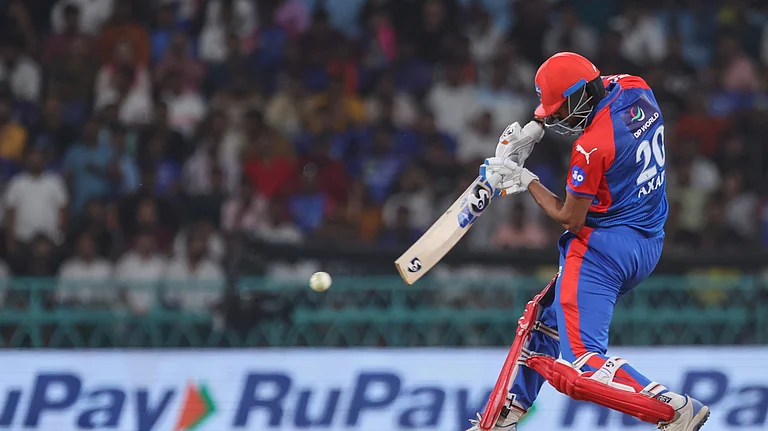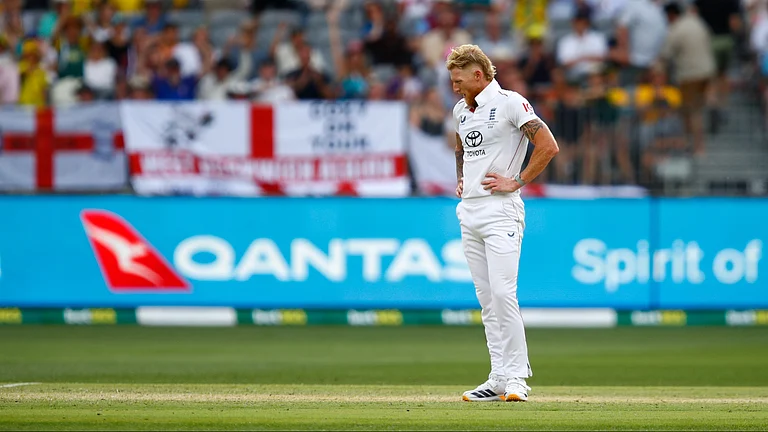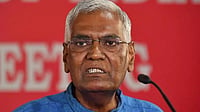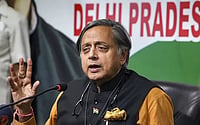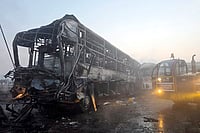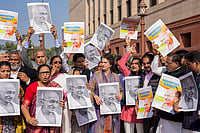Hum Aap ke Hain Koun (HAHK) rewrote the record books several times over as the audiences made a beeline for the theatres. They came in droves. And the temporary slump in cinema attendances of the early '90s was quickly consigned to the pages of Bollywood history. The syrupy cinematic confection ran to jampacked houses for months on end, thereby achieving what had until then looked well-nigh impossible: it yanked the crowds away from the blabbering boob tube and brought them right back where they belonged. Madhuri Dixit metamorphosed into a subcontinental icon, the Rajshri film passed into tinsel town folklore, and its unprecedented commercial success became the bonne bouche of animated tete-a-tetes all around the land, as much at small-town street corners as on the metropolitan cocktail circuit.
For the first time since satellite TV swept the nation in the early '90s, the cinema cash counters were ringing again. But the sceptics, being sceptics, were still wont to dismiss the HAHK phenome-non—which, incidentally, translated into business worth an unheard of Rs 150 crore—as a random shot, a flash in the pan, a box-office freak unlikely to be ever replicated.
They obviously hadn't reckoned with Dilwale Dulhania Le Jayenge (DDLJ), yet another squeaky clean, diligently sanitised family entertainer, this time from the Yash Chopra stable. It has matched HAHK week for week and has so far raked in upwards of Rs 75 crore. In fact, during its first six weeks, DDLJ outstripped HAHK's collections. Finally, this abbreviation too settled down to play a none-too-brief innings at the box office. And betwixt HAHK and DDLJ came other big grossers: Mani Ratnam's bilingual Bombay, Indra Kumar's Raja and Ram Gopal Verma's Rangeela. Movies are back in business. Very Big Business.
"People have undoubtedly started flocking back to the theatres," says one-time whizkid director Rahul Rawail. "They are sick of the video and cable habit, which was threatening to kill the social activity of movie-going," says the man who, in the '80s, made the visually stunning and structurally brilliant Arjun, a box-office hit that was way ahead of its time. Raj N. Sippy, another of the '80s Bollywood 'movie brats' who had sought to steer popular Hindi cinema out of the morass of mediocrity with films like Inkaar and Satyamev Jayate, echoes Rawail: "The resurgence of cinema has something to do with the idiot box. Ninety-eight per cent of TV is pure junk. How much of Antakshari can you ultimately watch? What the big screen can offer the viewer in terms of technique and spectacle, television can never hope to."
The reason is obvious: the act of watching television is bereft of the excitement and the lively social experience that a visit to the movies offers. Quite apart from the fact that (despite the steep hike in ticket rates) cinema remains the cheapest, most acceptable and safest form of recreation for the young and old alike, the magic of taking in a film on the big screen in a darkened, cavernous theatre has a charm absolutely its own. Especially for the young and restless, a segment forever looking for entertainment avenues. Discos, nightclubs and pubs are out of bounds for both societal and pecuniary reasons. So cinema halls, the better ones at any rate, become the fulcrum of the recreational plans of large sections of Indian society. "Why else," argues Aditya Khanna of New Delhi's Chanakya cinema, "would a patron drive down all the way from Model Town (in north Delhi) with his family or friends to watch a film here? It's for the experience."
In real terms, what does this renewed mass interest in cinema imply? Accurate figures are always difficult to come by, given the disorganised nature of the Indian film industry. But informed guesstimates put the weekly all-India theatre occupancy at a very healthy 11 crore, up from a little over 8 crore in 1993-94, an increase of nearly 40 per cent in two years.
Santosh Singh Jain, president of the Film Distributors' Council (FDC) and vice-president of the industry's apex body, the Film Federation of India, attributes the dramaticrise in cinema attendances to two factors: an improvement in the quality of filmmaking, thanks to an influx of young directorial and acting talent, and the landmark agreement between the FDC and the Film Makers' Combine to distance the theatrical and video release of a film by at least six months. The result, he says, is there for all to see. "In the past, a film would be released in 15 theatres and by the third week it would be playing at one. DDLJ, on the other hand, has been running in over 15 theatres in and around Delhi for 10 weeks now and is showing no signs of slowing down," says Jain, who has been in the film distribution business for half a century. Clearly, the most salutary move of the '90s has been the holding back of video releases of big films. The legal videocassettes of Raja and Coolie No. 1 were released 25 weeks after these films made it to the movie halls, whereas those of Rangeela, Bombay, Karan Arjun, HAHK and DDLJ are still not in the market. "The move," says Sippy, "paid off in the case of Karan Arjun, HAHK and DDLJ, but didn't for Trimurti and Akele Hum Akele Tum." What that clearly proves is that Big is not necessarily Beautiful anymore. Bold is. Gone are the days of giant banners and saleable stars. The hero today is the film itself. As the cinema-going public gets younger—the National Readership Survey 1995 shows that 38 per cent of urban adults in the 15 to 24 age group go to the movies at least once a month—and narrative innovation and technical perfection have assumed paramount importance.
"I know my audience profile," says Khanna. "I'm extremely conscious of their likes and dislikes. I can't but give them quality products." In the past year, Chanakya has run 1942 A Love Story, HAHK,Bombay, Rangeela, Akele Hum Akele Tum, besides Forrest Gump, Philadelphia and A Walk in the clouds, not one of them a formulaic product. "The young are frequenting cinemas more than ever before and there's no reason why a guy who goes for Forrest Gump wouldn't be interested in Rangeela or Bombay ," Khanna rationalises. That's why Chanakya, which attracts nearly 12 lakh ticket-buyers each year, has adopted a dual-language product mix.
Mani Ratnam, the filmmaker with the mid as touch, sees a rosy future. "Cinema seems to have made a comeback, if you go by statistics," he says. Films like HAHK, DDLJ, Bombay and Rangeela have up-ended conventions and yet have hit the bull's eye. This, says Ratnam, has sounded the death-knell of the Formula. Maybe for good. This, of course, is not the first time popular directors in Bombay have tried to break free from conventions. In the '80s, Raj Sippy made Inkaar , a film that had the fog feel and a lot of backlighting. "I did try to make films that were different, but some people felt they were too American in their style," he says. Boxer , for instance, received rave reviews but it was on the mat by the second day, he recalls. Repeated commercial failure forced Sippy, Rawail, Mukul Anand and J.P. Dutta back into the cocoon of the Formula.
But this time around, "different" cinema seems to have attained a degree of permanence. Ratnam insists that the difference between the '80s, when the Bollywood movie brats failed to sustain their efforts, and the mid-'90s is immense. "Imitating a Hollywood movie in form is one thing," he says. "What has changed now is not just the form but also the content of our films, and this trend is certain to last." Quite so, acquiesces Sarabjit Singh, general manager, Paramount Films of India. "Production value is what makes or unmakes a film. But what is equally vital is that the film must offer something that takes the audience by surprise," he says. Predictable plotlines and safe stereotypes are out. "Both HAHK and Jurassic Park (one of the many dubbed Hollywood films that have done well in India in the past two years) were well-crafted films, and not the usual fare. The impact of these films would have been lost on the small screen," says Singh. The same goes for Goldeneye , the James Bond film released in the last weekend of 1995 by Paramount allover India. And for all the other Hollywood imports that made waves in the recent past. In late 1994, Speed set a national box-office collection record of Rs 7.85 lakh in its first week at Priya, the theatre that has completely revolutionised the movie-going experience in the capital through a series of innovative measures introduced by proprietor Ajay Bijli. In its first week (35 shows) at Chanakya, Goldeneye topped Rs 5.5 lakh. In September last year, Mask made Rs 5.25 lakh during a week of 42 shows, while Jurassic Park mopped up Rs 4.45 lakh in its best week. Consider the fact that Mask did its business in September while Goldeneye opened in December-end (regarded as a lean period), and it's easy to assume that the movie-going habit is not only back in a big way, it's here to stay.
When the new-look Priya, which was not originally an established English movie outlet, reopened in June1991, its occupancy rate was no more than25 to 30 per cent. Today, it's 70 to 75 per cent. "It took us some time to convince our patrons that we were different. By 1994-end, occupancy had risen by 20 per cent. It was Jurassic Park that helped us get the people back," says Prashant Srivastava, corporate affairs manager, Priya Exhibitors. The theatre now draws an annual average of 15 lakh. Occupancy levels are definitely rising, says T.S. Hari-kumar, a partner in Bangalore's Pallavi theatre. "Theatres in the city had an occupancy rate of less than 50 per cent during 1992-93, when cable TV was at its peak. We now average 80 to 90 per cent," he adds.
Doubtless, quality is the key. Says Anil Thadani, who owns a theatre chain in Bombay: "Formula has lost the race. Sensible entertainers with an emphasis on good, hummable music are increasingly being thrown up. As a result, 1995 turned out to be the best year for the industry in a long, long time." Santosh Singh Jain agrees with Thadani's view that upgradation of facilities at the-atres, together with the state government's decision to slash entertainment tax, helped woo audiences back. "With the exemption being granted to movie halls in Maharashtra, theatre-owners have been able to invest in infrastructural revisions. This, in turn, has made movie-going a much more attractive proposition," says Jain.
The consensus now is that television, initially perceived as a threat to cinema, has actually proved to be an ally. One, the competition from the small screen has galvanised theatre-owners into action. "The theatre experience is improving as the best available technology and facilities are being made available to the viewers," says Sarabjit Singh. To lure the audience back, multiplexes are being planned in different parts of the country.
Satellite TV has aided cinema in a more direct way by sensitising fans to the latest trends and movies in the West and by providing a powerful publicity platform for indigenous products. Says Srivastava: "The film-based programmes and promos on TV have whetted the appetite of movie-goers." Kamal Kapoor, proprietor of Bangalore's Rex theatre, which exclusively screens Hollywood films, corroborates this: "The star interviews, film clips, trailers and songs push people towards theatres." Although the ratio of films that bomb hasn't gone down, all roads are leading once again to the movie halls. And the equations have changed. Until recently, a film would be certified a super-duper hit if it managed anything between Rs 10 and 15 crore. HAHK and DDLJ have proved that business of Rs 100 crore is well within the realms of the real.
So the dream merchants are effecting quick changes to their world of make-believe. For they now know exactly whose side the audience is on. The question— Hum Aapke Hain Koun? —has been answered. And without ambiguity.







